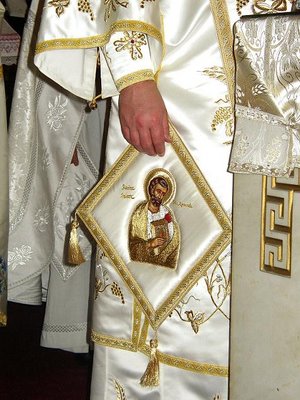Difference between revisions of "Epigonation"
(es:Epigonation) |
|||
| Line 1: | Line 1: | ||
[[Image:Epigonation.jpg|right|thumb|300px|Epigonation of Bp. [[Mark (Maymon) of Toledo]], featuring his patron saint, the [[Apostle Mark]].]] | [[Image:Epigonation.jpg|right|thumb|300px|Epigonation of Bp. [[Mark (Maymon) of Toledo]], featuring his patron saint, the [[Apostle Mark]].]] | ||
| − | The '''epigonation''' (from Greek, "upon the knee") is a stiff, diamond-shaped vestment worn on the right side by [[priest]]s and [[bishop]]s. | + | The '''epigonation''' (from Greek, "upon the knee") is a stiff, diamond-shaped vestment worn on the right side by [[priest]]s and [[bishop]]s. |
| + | |||
| + | In the Byzantine tradition, the epigonation is awarded to a priest upon his elevation to ''exomologoumenos'' (confessor). In the Russian tradition, it is an award given after many years of service. | ||
| + | |||
| + | It represents a shield, originating from the thigh shield worn by soldiers during the days of the early church. The epigonation holds a dual meaning. First, it denotes the celebrant as a "soldier" of Christ. Second, it symbolizes the Word of God, fighting the wiles of the enemy. The epigonation is known as the ''palitsa'' in the Russian tradition. | ||
{{stub}} | {{stub}} | ||
Revision as of 21:05, November 19, 2007
The epigonation (from Greek, "upon the knee") is a stiff, diamond-shaped vestment worn on the right side by priests and bishops.
In the Byzantine tradition, the epigonation is awarded to a priest upon his elevation to exomologoumenos (confessor). In the Russian tradition, it is an award given after many years of service.
It represents a shield, originating from the thigh shield worn by soldiers during the days of the early church. The epigonation holds a dual meaning. First, it denotes the celebrant as a "soldier" of Christ. Second, it symbolizes the Word of God, fighting the wiles of the enemy. The epigonation is known as the palitsa in the Russian tradition.
This article or section is a stub (i.e., in need of additional material). You can help OrthodoxWiki by expanding it.
